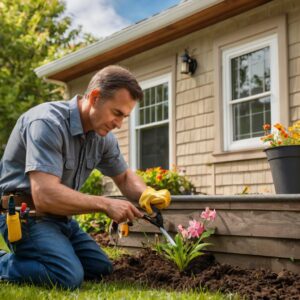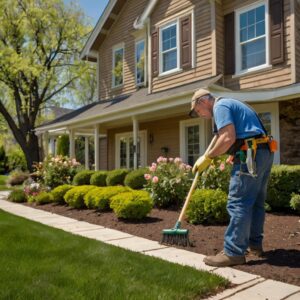
As winter’s chill begins to fade and warmer weather approaches, you’re probably excited to trade in your heavy coats and boots for lighter fabrics and sandals.
But before you break out the BBQs and outdoor decor, make sure your home is ready for its new season
Just like a car needs an oil change every 3 months or more depending on conditions, it’s equally important to give your house some seasonal care too. But not everyone knows where to start.
That’s why we’ve put together these simple and practical checklists, so you can get your home in top shape for spring with minimal effort.
From HVAC maintenance tips and plumbing checks to gardening advice and more, our Spring into Savings guide has everything you need.
Winter is Coming to an End But Is Your Home Ready?
As winter starts to fade, it’s time to inspect your home for any damage caused by cold weather. Take a look around for signs of wear and tear on your roof, walls and gutters.
The sun may shine brighter soon, bringing with it an increased risk of damage from UV rays on windows and blinds. Inspect the seals around doors and windows too.
Check that all pipes are insulated properly to avoid freezing during warmer months ahead. Make sure there are no leaks or signs of water damage either.
Also inspect your outdoor furniture, cushions should be replaced if they’re stained or damaged beyond repair, don’t leave them out any longer than necessary. This could cause further damage and an unpleasant musty smell when you go back to it in the warmer months.
Don’t forget about your lawns. If there’s a lot of growth from winter it may need mowing before you know it.
The Importance of Early Spring Maintenance for Energy Efficiency
High energy bills can be devastating this time of year, especially when it feels like your air conditioning is running non-stop. But did you know that a well-maintained HVAC system can save you hundreds on your utility bill and extend its lifespan by years? Regular spring maintenance can make all the difference.
Spring is the perfect time to tackle some crucial tasks to ensure your heating, ventilation, and air conditioning (HVAC) system runs smoothly throughout the warmer months. This simple checklist will help prevent costly repairs down the line and keep you cool while saving money on energy bills.
Filter Frenzy
Dirty air filters are like clogs in your drains – they’re easy to ignore, but can cause big problems. Replace those old filters with new ones every season to ensure proper airflow and prevent damage from dust and debris.
Try this trick: When checking filter replacements, look for the Energy Star rating or replace them at least once a year to take advantage of cost savings.
Inspect & Seal
Ducts are like air pipes – if they’re damaged or leaky, your AC system works harder than it needs to. Use a flashlight and a screwdriver (or hire a pro) to inspect for cracks, gaps, and loose connections in your ductwork.
When sealing those leaks, seal them with mastic tape or fiberglass insulation for long-lasting results.
Thermostat Tune-Up
A well-set thermostat is like the conductor of an orchestra – it keeps everything harmonious. Adjusting temperature settings can save up to $200 on energy bills and extend your system’s lifespan by preventing extreme conditions.
Try this hack: Set your thermostat to heat at least 6 hours before you sleep, saving around 3% on heating costs each day.
Ventilation Vibes
Don’t neglect outdoor components – a clear drain will keep your AC unit running smoothly. Clear leaves and debris from condenser coils every spring or fall.
When clearing out those vents, use soft brushes to avoid damaging them.
By following these simple steps, you’ll enjoy a more comfortable climate without breaking the bank this summer. Stay cool and save money with regular maintenance!
Spring Cleaning for Clogged Gutters and Downspouts
Clogged gutters can cause costly damage, so it’s essential to prioritize their cleaning before warmer weather sets in. This task is often overlooked until a major problem arises, but regular maintenance can save you thousands of dollars and ensure your home remains secure.
Clogged gutters are more than just a nuisance; they pose significant risks to the integrity of your foundation and overall property value.
When water accumulates due to clogs, it can lead to:
- Water accumulation causing structural damage: A single inch of water can cause over $1,000 in damage. Regular cleaning ensures your foundation remains safe.
- Pest infestations due to stagnant debris: Check for signs of rodent activity or insect eggs around downspouts and gutters. These unwanted guests not only compromise the health and safety of you but also spread diseases.
Regular cleaning of these components is crucial, especially as they can lead to:
- Before beginning the cleanup process:
- Remove any large debris that has accumulated in the gutters using a scoop or trowel.
For more stubborn blockages, mix 1 cup of baking soda into 1 gallon of water to create a gentle cleaning solution. This paste helps remove debris without scratching your gutters.
After removal:
- Rinse downspouts thoroughly to remove any remaining debris and inspect gutters for sagging or rust.
By prioritizing gutter maintenance in the spring, you’ll be better equipped to handle inclement weather conditions later on.
Regular upkeep can help prevent:
- Expensive repairs: Replacing downspouts and gutters after water damage.
- Increased pest activity: Rodents and insects make homes out of old debris, leading to costly infestations.
For seamless gutters, use a specialized scoop to remove debris without scratching the surface. For other systems, consider using gloves with reinforced palms for extra grip when reaching into tight spaces. When dealing with clogs that require a baking soda solution, mix 1 cup of the paste into a bucket or container. This gentle cleaner can help remove debris without scratching your gutters.
Finding Hidden Leaks in Your Roof During Warmer Weather


Warmer weather is just around the corner, but are you prepared for its financial consequences? As leaves pile up on your property, it’s easy to get caught up in yard work and forget about another crucial maintenance task: inspecting your roof for hidden leaks. This simple check can save you thousands of dollars in costly repairs down the line.
Leaks that go unnoticed can cause significant damage to your roof’s structure and compromise its integrity. In severe cases, they may even lead to structural collapse or total loss of property value. For example, a single leaky shingle can waterlog the surrounding wood, causing it to warp and crack over time. Mineral deposits from stagnant water can also leave unsightly discoloration on your roof’s surface.
To find hidden leaks in your roof, follow these steps:
- Inspect damaged or missing shingles: Start by checking the edges and corners of your roof where water tends to accumulate. Look for signs like curled or torn shingles, which may be a result of wind damage or age.
- Check sagging surfaces: Water accumulating on specific areas can cause wood warping and cracking. Discolored marks from mineral deposits are another common sign that leaks need attention.
Hiring a professional roofing inspector is an excellent idea if you’re unsure where to begin. They have the training, expertise, and equipment needed to detect issues before they become major problems.
To inspect your roof effectively, consider hiring a pro for the following areas:
- Checking gutters and downspouts: Debris accumulation can cause significant damage over time.
- Examining flashing around chimneys and vents: Leaks in these areas are often overlooked but can lead to costly repairs.
By being proactive with your roof’s maintenance during warmer weather, you’ll be able to avoid expensive problems. Imagine saving $1,000 or more on repairs by catching those pesky leaks before they become major issues! Regular inspections will help prevent such scenarios and keep your home safe from costly damages.
DIY Solutions For Repointing Mortar Between Bricks
Mortar between bricks can deteriorate over time, causing cracks that let water seep into your home’s foundation. This is particularly problematic in warmer weather when temperatures rise and soil shifts.
For instance, if you notice signs of mortar deterioration, it could lead to increased energy bills due to heat escaping through gaps or even structural damage if the issue is left unchecked. Just like how a small leaky faucet can turn into a costly plumbing nightmare over time, poorly maintained mortar joints can have far-reaching consequences on your home’s integrity.
I’ve seen this happen in my own neighborhood – poor mortar conditions led to a homeowner experiencing skyrocketing energy bills and structural damage! Repointing the mortar isn’t just for DIY enthusiasts; it’s necessary for maintaining your property. In fact, many professional contractors recommend regular repainting of mortar joints as part of their maintenance services.
To fix the issue:
- Use a hammer, chisel, or wire brush to remove old mortar from joints.
- Mix cement-based grout according to manufacturer instructions and apply it generously between each joint using a pointing trowel or brush. Be sure to follow safety precautions when working with power tools and materials.
- Wipe away excess material with a damp cloth.
If you’re not comfortable with DIY projects or if the damage is extensive, consider hiring a professional contractor who specializes in exterior home repairs. In fact, some contractors recommend repointing mortar between bricks as part of their annual maintenance contracts for homeowners.
Don’t wait until it’s too late! Early intervention can make all the difference in preventing more severe problems from arising down the line.
Top Signs That Need a Home Inspection Before Maturity
Spring into savings by tackling these common seasonal home maintenance challenges before they turn into costly repairs. As your house adjusts to warmer weather, it’s more prone to issues that may seem minor now but can become major headaches later on.
Slight Cracks in Foundations
A small crack in the foundation is never insignificant; if you notice one, inspect further because water seeping behind it could cause soil erosion. This might not be a pressing concern yet, but neglecting it can result in costly repairs down the line. Address this by consulting with an expert or taking photos to track its development.
Cracks & Crevices around Windows/Doors
If you spot cracks or crevices around windows and doors, don’t ignore them! These entry points for pests like rodents or cockroaches may seem minor now but could lead to significant damage. Seal those gaps using caulk and weatherstripping to save yourself from unwanted critters.
Holes in Walls/Ceiling
You might have already noticed it, but if you’ve found a hole or crack in walls or ceilings, consider taking action quickly! Water damage caused by clogged gutters can lead to mold growth if left unattended. Regularly inspect your roof and clean those gutters with ease this spring.
By being proactive about home maintenance during warmer weather, you’ll save yourself the hassle of dealing with costly repairs down the line, not to mention prevent potential health risks and structural damage.
Keeping The Lawn Safe from Pests and Diseases this Spring Season.
Spring into action means it’s time for lawn maintenance. Pests and diseases can quickly ruin a beautiful lawn, so stay on top of these potential threats.
As your grass awakens from winter, pests and diseases begin to emerge. This is the perfect opportunity to catch them off guard before they cause significant damage. With the right knowledge, you’ll be able to protect your lawn’s defenses and enjoy a healthy outdoor space all season long.
Pest Control:
Think of it this way – maintaining vigilance over pests is like having air traffic control for your lawn’s health. By being aware of common springtime critters and their behaviors, you can take steps to prevent infestations from getting out of hand. Some popular pest culprits include whiteflies, aphids, and caterpillars.
Whiteflies are notorious for laying egg masses on the underside of leaves in clusters that resemble cottony clumps. If left unchecked, these tiny pests can dehydrate your grass by sucking sap from blades. Look for yellow or stunted leaves as a sign of an infestation – this could be discolored, distorted, or simply dehydrated.
Aphid infestations often manifest in similar ways: aphids are attracted to certain types of grasses and will feed on the sap until it causes damage.
To identify them:
- Inspect your lawn carefully for clusters of eggs resembling cottony clumps
- Watch for areas with yellow or stunted leaves
Early detection is key – by being proactive, you can prevent infestations from getting out of control.
Diseases also pose a threat to healthy lawns this spring. Keep an eye out for telltale signs:
Fungal infections like powdery mildew often appear as discolored spots or lesions on blades. As the temperature rises, diseases thrive – staying ahead of these threats is crucial to maintaining your lawn’s health.
Powdery Mildew:
Rust and powdery mildew are two common fungal diseases that can wreak havoc in warmer temperatures.
When it comes to preventing these issues, vigilance is key:
- Inspect leaves regularly for white or orange spots
- Recognize areas with uneven growth patterns
Don’t let pests and diseases ruin your lawn’s beauty – stay ahead of the game by recognizing their signs early on.
By keeping an eye out for these potential threats, you’ll be able to take proactive steps to protect your lawn.
Spring Maintenance of Garage Doors To Prevent Unexpected Damage


As spring approaches, it’s time to inspect your garage door and ensure it’s in top condition. A well-maintained garage door can prevent unexpected damage and keep you safe.
Check the springs
If your springs are not properly tensioned, they may become over-stretched or under-tensioned, leading to uneven movement and premature wear on the door’s framework.
Look for signs of frayed or damaged wire – this could compromise safety.
Inspect the rollers
Think of your rollers like a vital component in a smooth-running machine: if you neglect them, your garage door might not open and close smoothly. For example:
Look for signs of dry-out on the rubber surface
Check for cracks or brittleness – these could indicate wear
Regular checks will help prevent damage
Check seals
You don’t want a sticky garage door, which can be frustrating to fix!
Regularly checking and replacing worn-out seal cords can help maintain smooth operation and prevent premature wear on moving parts.
Inspect hinges
Don’t let rusty hinges get in the way of your garage door’s proper functioning.
Regular checks will keep you safe from accidents caused by a faulty hinge.
Check cables
If you notice worn-out wires, inspect and replace them to avoid costly repairs down the line.
Failure to do so might cause your opener to stop working altogether – a situation worse than just having a jammed door
Assessing Your Home’s Air Conditioning Unit for Peak Performance
As summer approaches, you may be thinking about how to beat the heat. But did you know that a well-maintained air conditioning unit can save you up to 10% on your energy bills? Neglecting AC maintenance can lead to costly repairs and reduced system performance.
To ensure your home stays cool and comfortable during warmer months, it’s essential to evaluate the health of your air conditioning unit. Here are some key checks:
Dirty Air Filters:
A dirty air filter is one of the most common problems people experience with their ac system. When you have a dirty air filter, it can cause a drop in performance and decrease efficiency by up to 30%. This reduces airflow, leading to higher energy bills and decreased comfort levels.
Regular cleaning or replacing the unit’s filters as needed won’t be hard to do. Set reminders for every 3-6 months, schedule regular tune-ups with your local HVAC technician, or replace the filter yourself using a replacement kit.
Clogged Air Coils:
After several months of operation, air coils can become clogged with dirt, grime, and other debris. When this happens, it can lead to reduced airflow and decreased system performance. According to the U.S. Energy Information Administration, dirty coils account for up to 25% of a
home’s total energy loss.
To keep your air conditioning unit running efficiently all season long, inspect and clean or replace the coil as needed.
Refrigerant Leaks:
Over time, refrigerants can seep out through cracks in the system. This can cause decreased performance, higher energy bills, and potentially even costly repairs. If you suspect a leak is occurring, contact your local HVAC professional to identify and fix the issue before it becomes a bigger problem.
Regular maintenance should always be on top of mind when it comes to an AC unit’s
performance.
Seasonal Maintenance: The Key To A Longer Lasting Home


Great home maintenance can save homeowners money in the long run. Regular seasonal checks allow for potential issues to be identified and addressed before they become major problems, which would require costly repairs down the line.
The sooner these tasks are completed, the more likely it is that common household systems will last longer without needing replacement or repair. In turn, this can save homeowners money on utility bills as well as extend the lifespan of their property’s infrastructure.
By prioritizing seasonal home maintenance at AOneTechnicalServices.com, homeowners can ensure a safer and healthier living environment for themselves and their families. So don’t wait book an appointment with us today to get your spring into savings!


